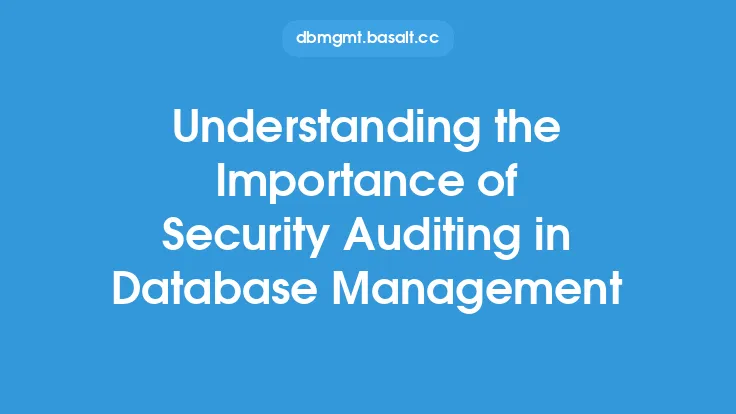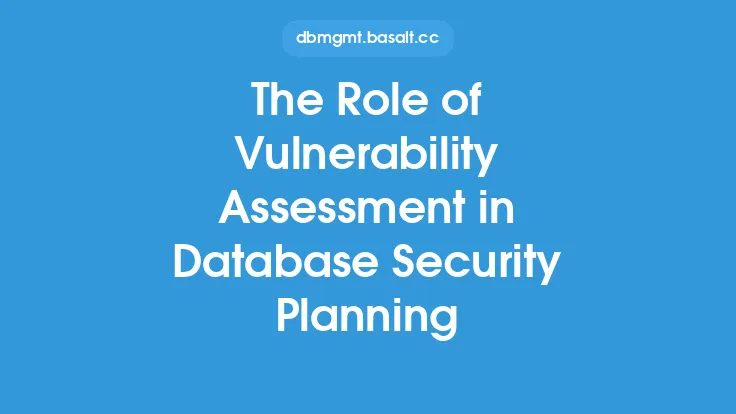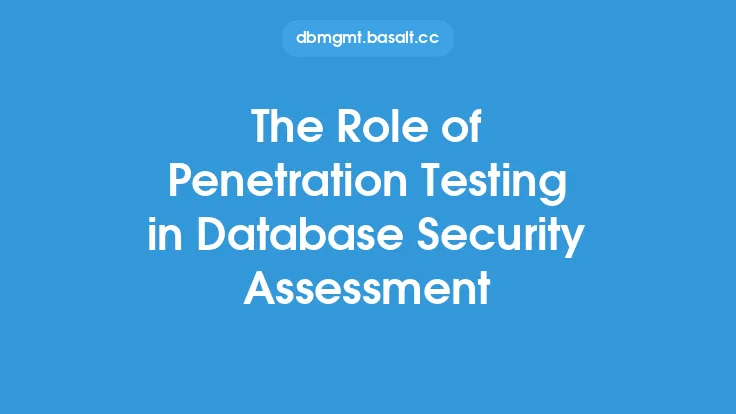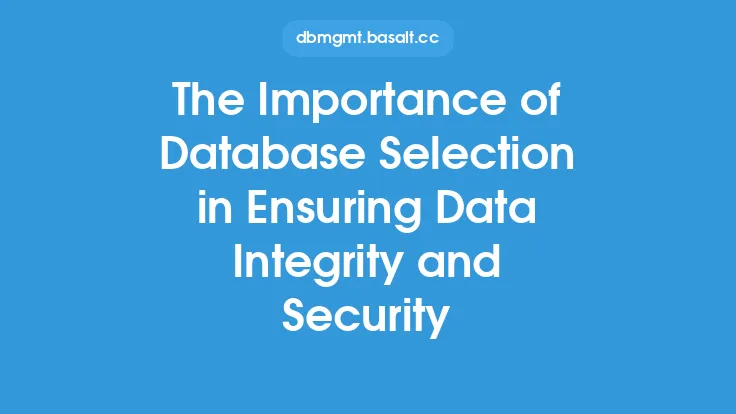Security auditing plays a crucial role in identifying database vulnerabilities, which is essential for maintaining the integrity and security of an organization's data. A database security audit is a comprehensive examination of a database's security posture, aimed at identifying potential vulnerabilities, weaknesses, and threats that could compromise the confidentiality, integrity, and availability of the data. In this article, we will delve into the role of security auditing in identifying database vulnerabilities, the types of vulnerabilities that can be identified, and the benefits of regular security auditing.
Introduction to Database Vulnerabilities
Database vulnerabilities refer to the weaknesses or flaws in a database's design, implementation, or configuration that can be exploited by attackers to gain unauthorized access, steal sensitive data, or disrupt database operations. These vulnerabilities can be classified into several categories, including SQL injection, cross-site scripting (XSS), buffer overflows, and privilege escalation. SQL injection, for example, occurs when an attacker injects malicious SQL code into a database query, allowing them to access, modify, or delete sensitive data. XSS, on the other hand, involves injecting malicious code into a database-driven web application, which can then be executed by the browser, allowing the attacker to steal user credentials or take control of the user's session.
The Security Auditing Process
The security auditing process involves a series of steps, including planning, data collection, analysis, and reporting. The planning phase involves identifying the scope of the audit, defining the objectives, and selecting the audit tools and techniques. The data collection phase involves gathering information about the database, including its configuration, user accounts, and access controls. The analysis phase involves examining the collected data to identify potential vulnerabilities and weaknesses, while the reporting phase involves documenting the findings and recommending remedial actions. The security auditing process can be performed manually or using automated tools, such as vulnerability scanners and penetration testing tools.
Types of Database Vulnerabilities Identified by Security Auditing
Security auditing can identify a wide range of database vulnerabilities, including configuration vulnerabilities, authentication vulnerabilities, authorization vulnerabilities, and data encryption vulnerabilities. Configuration vulnerabilities occur when a database is not properly configured, allowing attackers to exploit weaknesses in the database's setup. Authentication vulnerabilities, on the other hand, occur when a database's authentication mechanisms are weak or flawed, allowing attackers to gain unauthorized access. Authorization vulnerabilities occur when a database's access controls are not properly configured, allowing users to access sensitive data or perform actions they are not authorized to perform. Data encryption vulnerabilities occur when sensitive data is not properly encrypted, allowing attackers to intercept and read the data.
Benefits of Regular Security Auditing
Regular security auditing is essential for maintaining the security and integrity of a database. The benefits of regular security auditing include identifying and remediating vulnerabilities before they can be exploited, ensuring compliance with regulatory requirements, and improving the overall security posture of the database. Regular security auditing can also help to identify and address configuration weaknesses, authentication flaws, and authorization vulnerabilities, reducing the risk of a security breach. Additionally, regular security auditing can help to ensure that sensitive data is properly encrypted and protected, reducing the risk of data theft or unauthorized access.
Tools and Techniques Used in Security Auditing
A variety of tools and techniques are used in security auditing, including vulnerability scanners, penetration testing tools, and configuration analysis tools. Vulnerability scanners are used to identify potential vulnerabilities in a database, while penetration testing tools are used to simulate attacks on a database to test its defenses. Configuration analysis tools are used to examine a database's configuration and identify potential weaknesses or flaws. Other tools and techniques used in security auditing include SQL injection testing tools, cross-site scripting testing tools, and buffer overflow testing tools.
Best Practices for Security Auditing
Several best practices can be followed to ensure effective security auditing, including conducting regular security audits, using a combination of manual and automated testing tools, and involving multiple stakeholders in the auditing process. Conducting regular security audits helps to ensure that vulnerabilities are identified and remediated in a timely manner, reducing the risk of a security breach. Using a combination of manual and automated testing tools helps to ensure that all potential vulnerabilities are identified, while involving multiple stakeholders in the auditing process helps to ensure that all aspects of the database's security posture are examined.
Common Challenges in Security Auditing
Several challenges are commonly encountered in security auditing, including the complexity of modern databases, the lack of skilled security auditors, and the limited resources available for security auditing. Modern databases are often complex and sophisticated, making it difficult to identify and remediate vulnerabilities. The lack of skilled security auditors can also make it difficult to conduct effective security audits, while limited resources can make it challenging to allocate sufficient time and budget to security auditing.
Conclusion
In conclusion, security auditing plays a critical role in identifying database vulnerabilities, which is essential for maintaining the integrity and security of an organization's data. By conducting regular security audits, organizations can identify and remediate vulnerabilities, ensure compliance with regulatory requirements, and improve the overall security posture of their databases. The security auditing process involves a series of steps, including planning, data collection, analysis, and reporting, and can be performed manually or using automated tools. Several best practices can be followed to ensure effective security auditing, including conducting regular security audits, using a combination of manual and automated testing tools, and involving multiple stakeholders in the auditing process. By following these best practices and using the right tools and techniques, organizations can ensure the security and integrity of their databases and protect their sensitive data from unauthorized access or theft.





